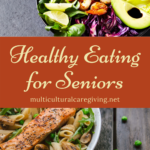
Updated April 16, 2021
Healthy eating for seniors can often seem like an incredibly difficult idea. There are so many messages out there about radical changes that we need to make, like cutting out all added sugar, going on a low carb or keto diet, eating only organic food, or dramatically decreasing fat intake.
Not only are some of the recommendations difficult to achieve, many also contradict one another. The whole field gets overwhelming fast, especially for people who face practical or emotional challenges when it comes to food.
To make matters worse, seniors and caregivers may face a whole host of other challenges at the same time. Some of these can be resolved, but you may simply need to work within other ones.
Senior Healthy Eating Challenges
The Need for Soft Food
Eating tough food often gets more difficult with age. The degree of difficulty can vary. Some seniors simply require that food is cut up for them or that meat is cooked so that it is tender.
Others may need to focus only on soft foods. There are plenty of soft foods for seniors out there, along with amazing recipes that you can try.
Even so, some people struggle with the transition to soft foods. This can sometimes happen because the decision feels like ‘giving up’. Others may simply not know how to make soft food that also tastes good. The right recipes can help with these areas. It’s also helpful to plan meals so that they are enjoyable and taste great.
Decreases in Taste or Appetite
While we’re talking about the flavor of food, it’s worth mentioning that a person’s ability to taste often decreases with age. This tends to make food less interesting and can make it blander.
Appetite often declines as well. This might happen because of a decrease in the ability to taste or independently.
Either way, these areas present challenges.
Making food more appealing and ensuring it tastes good are key ways to combat the issues. For example, including more herbs and spices can make meals taste more interesting. Having multiple textures present is useful as well.
In some cases, the senior might fare better with multiple small meals in a day. Small meals tend to be easier to eat and can seem less overwhelming than a couple of large meals.
You can also consider nutritional shakes. These provide plenty of nutrition and are easy to consume. They can also taste appealing, so seniors may be more likely to drink them. You can choose whether to make your own protein shakes or rely on pre-prepared options like Ensure and Boost.
Food Preparation
This is a big one. Seniors may struggle to prepare their own food for many reasons. Caregivers are sometimes able to take over food preparation, but this isn’t always possible.
Thankfully, there are some solutions. Services like Meals on Wheels are one example. You can also find paid meal delivery services, along with alternatives to meal deliveries.
Other Challenges
We’re only just scratching the surface with this list. There are plenty of other issues that seniors face, such as difficulty in physically using a knife and fork or cases where seniors are consuming too much food, rather than too little.
Perhaps the most important thing to remember is that there are strategies you can take to promote healthy eating for seniors.
Even if the problem can’t be entirely resolved, you can often find small changes that help to improve a person’s diet. This is true for your own eating and for someone else’s.
Considerations for Caregivers
Caregivers often face two key challenges with eating – the food they eat themselves and what the senior eats.
I personally struggled with my own eating as a caregiver. I found that there was never enough time and I was often short on energy. It was often easier to get a quick and unhealthy meal than to try and prepare something healthy (which would have used time that I simply didn’t have).
I was mostly caring for my partner and promoting healthy eating in him was an entirely different story. The techniques that I often use for my own health didn’t work for him. He was one of those people who wanted what he wanted.
Therein lies the challenge for caregivers.
You’re caring for someone who is their own person. In most cases, they retain the right to decide for themselves about the food that they eat – even if they’re compromising their own health in the process. After all, people do have the right to make poor food decisions.
Caregivers can help to improve the diet of their loved ones. You can focus on providing good food and even preparing it yourself.
But, if the senior doesn’t want to eat in a healthy manner, there may be little that you can do. You may have to be content with small changes.
Small Changes Can Be Powerful

There are many different approaches to healthy eating for seniors. We’re focusing on small changes because it’s often not easy to make dietary changes. We eat the way we do for many reasons, including habit, the foods we enjoy, priorities, ease of preparation, and emotions.
Making dramatic changes may work well in the short-term, but such changes are harder to stick to over time. Many of us feel resistant to such change and end up rebelling sooner or later. This issue can be even stronger if you’re supporting a senior who isn’t enthusiastic about improving their health.
Little changes, on the other hand, can feel less scary. It’s easy to make a few small changes at once and keep adding to these over time. This is a much easier way to approach healthy eating for seniors. Doing so might not be as ideal as, say, cutting out all processed food overnight. But, in the end, the most useful diet is the one that you can stick to.
My Own Experience
To illustrate this idea, let me talk about my own experience. I found healthy eating almost impossible as a caregiver (partly because I only learned about self-care and self-compassion after my caregiving journey was over).
I’ve never done well with restrictive eating either, finding that I can’t follow any diet for long.
One big shift for me was the decision not to see food as the enemy. I intentionally don’t focus on the idea of ‘right’ or ‘wrong’ foods. I hate the idea that any food should be avoided completely. Most foods have some advantages anyway.
I also don’t put a time frame on success. I try not to look for specific outcomes, like weight loss or increased energy. I know monitoring outcomes work for some people, but not for me. The process just makes me feel guilty whenever I don’t hit a specific goal.
As a result, I simply focus on the process. I take one step at a time – improving my diet and my activity as a go.
It’s taken me four years to lose weight and get healthy, and I still have a decent way to go. But, the important thing is that I’m getting healthier.
Practical Changes That You Can Make
Because people are so very individual, there is no ideal set of changes. The goal is to find approaches that point you in the right directions, ones that don’t feel overwhelming. Some examples include the following.
- Change the type of bread that you eat. This could involve shifting from white bread to whole grain or perhaps focusing on sprouted bread. Gluten-free bread or homemade bread are other options. This type of shift can help you decrease wheat intake and means you’re getting more nutrients – without giving up sandwiches.
- Focus on high-quality breakfast cereals. Look for brands that use little or no added sugar and few additives. Products that are high in protein and low in carbs are particularly good.
- Think about how many meals you eat. Some people do better with a few large meals. You could even try a variation in on intermittent fasting, where you decrease calorie intake by skipping breakfast. Many others prefer the opposite approach, where meals are smaller and more frequent. Frequent meals can be useful for seniors who struggle with their appetite.
- Don’t add sugar to your coffee. Think about other additions too, like creamer. What changes can you make with relative ease?
- Use unflavored Greek yogurt, then add berries or other ingredients to change the taste. Greek yogurt is more protein rich than most other types of nutrients. The unflavored version has little added sugar, giving you the chance to control the flavor and the sugar content.
- Choose individually wrapped chocolate and candy. This can be a more expensive approach, but it’s easier to stick to portion sizes when your food is individually wrapped.
- Use quinoa instead of rice or couscous. Quinoa can be used in a similar way to rice, but it is more nutritionally dense.
There’s one other thing to mention here.
I personally focus on solutions that are fast and easy. I have significant emotional problems around food, to the extent that I sometimes cannot cook and may struggle to eat. As a result, anything too difficult, I simply won’t do. My challenges may well get better with time, but my aim right now is to work within them.
A similar idea applies to caregivers and seniors.
It’s often best to start within your current limitations, rather than trying to push outside of them. So, if you absolutely love sugar and cream in your coffee – don’t make that the first thing you cut out. Leave it be until you’re ready to address that problem.
After all, the way we eat doesn’t have to be perfect. Food is allowed to be a source of enjoyment too.


Leave a Reply